This page pertains to the collaborative "Thrive Universe" project, and is not necessarily part of Thrive's official development. More information here
“I bestow everything under the skies to be your kingdom. The plants, the animals, the lands, the seas, the deserts and forests." — Dy'Essa speaking to E'Xhi Ha, the First Emperor. Passage from the Ma'kee'Danu
The Allosoph(AL-low-soef) (Allosophus Prudens, "Another Skillful Intelligent"), historically known as Ak, plural Ama, are a sentient species of bilateral vertebrates indigenous to planet Dengea.
Anatomy & Physiology[]
Allosoph typically stand 84 to 78 inches tall.
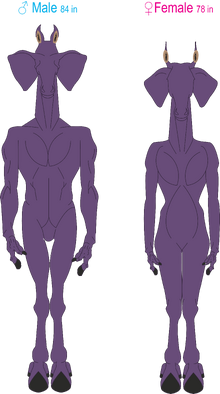
Male versus Female dimorphism
The Allosoph evolved to walk upright to forage the leafy tree canopies. The shock-absorbing bones of their quadruped ancestors forks at the elbow, forming one pair of forearms facing forwards and another pair facing backwards.
The Allosoph evolved separate from life on Earth, but their closest Earthly counterpart are the therapsids of the Prehistoric. They were mammal-like reptiles, warm-blooded but with a reptilian physiology.
Allosoph use stridulatory membranes for communication. Stridulation is the act of producing sound by rubbing together certain body parts. The mechanism is tone structure with a well-defined lip, ridge, or nodules (the "scraper" or plectrum) being moved across a finely-ridged surface (the "file" or stridulitrum—sometimes called the pars stridens) or vice versa, and vibrating as it does so, like the dragging of a phonograph needle across a vinyl record. The allosoph had no need to develop vocal cords, which sadly means humans cannot articulate allosoph languages, making face-to-face communication difficult. However, their languages are legible, and can be taught to humans.
The Allosoph have elongated eye stalks with large corneas on the bottom half. They are primarily a dinurnal species and as such possess a camouflaged dark complexion for sleeping.
The Allosoph are Folivores, adapted to eating leaves. However they only eat deciduous leaves, which grow seasonally. These plants were eventually domesticated and cultivated circa 13,000 BC. Leaves are high in cellulose, requiring a longer gestation period to digest.
Reproduction:[]
They are an egg-laying species. In Xhi tradition an allosoph's caste is determined by the color of their eggshell: grey eggs become Ak'Dani, the soldier caste, and pink eggs become Ak'Neer, the engineer caste. Incidentally the moons of Dengea are red and grey, are frequently referred to as the "Sky Eggs," Aunda'Essa.
Females have mammary gland on their backsides, tunnel-shaped orifices resembling exhaust pipes. Infants drink from the glands by sticking their tongues into the holes, licking up their mother's milk like a cat. When their teeth grow in they begin chew food normally.
Allosoph are a polygamous species. The male to female ratio is 10 to 1, causing many males to share a single female as a bride. These male harems are all viewed as equals, and all parent the female's children. Allosoph typically lay a clutch of half a dozen eggs, but due to the mother's multiple partners, many of her offspring inherit their traits from separate fathers. The female nurses her children, and the male harems provide for the family.
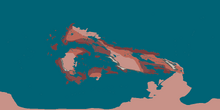
Geography map of Dengea
Homeworld[]

View of Tlo'Ahiya from Dengea's surface
The Allosoph are indigenous to the Planet Dengea (greek "Not Earth"), known in their language as H'Ama'Dun (The Mortal World). The planet's surface is about 16 percent land and 84 percent ocean. The planet has 2 major regions: The largely uninhabited southern continent, consisting of high mountains and plateaus, and the equatorial region home of the allosoph. The equatorial region is known in their language as dunkinama, literally "Land of the Living."
Orbiting the planet Dengea is the Tlo'Ahiya (White Arch) Ring System. In Allosoph Mythology the ring is believed to be the home of the sky diety Dy'Essa. Dengea also has two moons: Chau and Su. The smaller moon Chau is caught in a gravitational tug-of-war between Dengea and Su, causing friction and volcanic eruptions, similar to Jupiter's moon Io. From Dengea's surface Su appears as a grey-white ball, and Chau a reddish-orange inferno. That is why the words for "red" and "grey" are synonymous with the Moons.
Their homeworld orbits a Class-K, or orange dwarf known as Nim; and as such the flora has evolved a reddish-pink pigment to absorb the sunlight.
History[]
Paleolithic[]
The Allosoph Ancestors originated from the Megalodasos Rainforest in Eastern Dycegea 200,000 years ago, and gradually colonized the rest of the planet. The allosoph ancestors crossed the Southern ice sheet, reaching the Anatoligea continent 35,000 years ago.The first allosoph neolithic settlements appeared 8,000 yrs ago in the fertile Hesperides River Valley on the Dycegea continent.
Age of Divergence[]
Six major river valley civilizations developed in Dengea between 3000 to 1500 BC. On the Dycegean Continent the Great Sea Ad'Samu enabled trade and commerce between numerous civilizations, spreading ideology as well as technology. On the other side of the world in Northern Anatoligea the maritime Ocylym Empire became widespread and spread its theocratic teachings across the continent. The Great Library of Zirk and the Sacred Escalators of Oclym were constructed in the first millennium BC.
Some of the major civilizations and peoples of this time period include:
The Zorustians, a people who lived to the east of the Ad'Samu Sea. Their civilization stretched as far south as Arguvek and as far north as Shanga. Their monarchy was overthrown by a military dictator.
The Zirk, who lived west of the Ad'Samu Sea. They were rich and cultred people in the epicenter of major trade routes along the continent, connecting those west of the desert to those east of the Ad'Samu. With these trade routes their religion and technology spread around the known world. Without a clear heir to the throne in 410 AD, the empire collapsed into numerous petty kingdoms. The region was eventually reunified with the Astodorian conquests, beginning the reign of the Kozir Empire.
The Torics, who lived west of the Ad'Eji Desert. Their civilization was divided into numerous city-states, but eventually three major Toric kigdoms emerged: the Pat'Tora who resided south in the Patoran Mountain Range. The Fesmar, who lived closest to the Zirk and eventually adopted Zirkoism as their state religion, and the Kora'Tor, who would conquer the barbaric Eshana to the west and eventually all of the Toric Kingdoms and beyond. Their empire was the first to fall under the might of Xhi Anuga in 418 AD.
The Thourians, who lived east of the Eshana Sea. The Thourians were the first civilization to discover gunpowder, and aggressively expanded into northern Dytikus and the Western Isles. They were a large, secular empire with many religions, ethnicity and lifestyles swarming their dominion.
The Kore, who inhabited southern Dytikus. They established a large martime empire that stretched across all three continents. They formed a constitutional monarchy in 400 BC, and promoted ideas of free speech and education. Their colonial holdings were eventually granted the same democratic privileges as the provinces, establishing what would later be known as The Commonwealth. The Hiranq, Ocylym & Astodorians were all Commonwealth members at some point in their history. Eventually the Kore & Oclym merged into the Divine Union in 433 AD.
The Oclym, who lived in Anatolis. Their government consisted of a council of eight shaman, each said to represent one of the eight gods of their pantheon. A common ritual in their religion was the sacrifice of nonbelievers by pushing them off of large staircases into the rocky shores of their coastline. The Sacred Escalators are remnants of these ancient rituals. They eventually would unify with the Kore to form the Divine Union in 433 AD.
The Astodorians, who resided west of the Vorlish Gulf. Their first city was erected inside a crater in 500 BC. Legend has it the first settlers followed the tail of a falling star which led them to the fertile river valley. The Astodorians made contact with the Zirk in 400 BC and adopted zirkoism as their state religion. They would establish a maritime empire and fight many territorial campaigns against the Hiranq. In 410 AD, with the collapse of the Zirk Empire, the Astodorians invaded Zirk and crowned their king the new emperor of Kozir, Empire of the Zirkoists.
The Hiranq, who resided on the archipelago of the same name. Their people worshiped Sha'She, god of the Eastbound Wind. Their territorial ambitions were compromised by the encroaching Toric and Astodor Empires, leading to numerous border clashes and the dislocation of millions.
The Chausu, who resided to the far west of Borealis. Their religion was unique in that it did not worship a deity but a concept of knowledge and wisdom, preaching ideas of enlightenment.
The Anuga, who resided in the Pattoran Mountain Range. Their people lived for millenia in isolation high above in the cold Pattoran mountains until the invasion by the Toric empire. They were the first peoples to serve the Xhi, and defeated the Toric Empire in 418 AD.
The Littaka, who inhabited the Western Islands. They declared Independence from the Thourians in 450 AD.
Age of Feuds[]
Dengea's early age was ruled by a Xhi. Like any feudal society, under him were the E’Ga, the land owners, and some of these land owners liked to fight wars with Ak’Dani, the warriors. The samurai were in high demand and became organized into fraternities. They got into an argument with the Xhi government and defeated the Xhi, establishing the first ever Adgadun. The Xhi became only a figurehead. True power went to the Ad’Ga, or military leader, and those Ak’Dani warriors were now far more prestigious than those aristocrats.
On top of this new hierarchy we have the Ad’Ga, the greatest of the warlords. Under the Adga the E’Ga held lands, and under them were the Ak’Dani that served them. Below them were the labor class: the Ak’Neer
The E’Gas would tear apart the Ad’Ga in the most infamous era of Dengean History: The Age of Feuds. For over a century every E’Ga sought to seize position as Ad’Ga. Many wars were waged and many battle fought and the Ak’Dani were in their element. During the era the Allosoph made contact with humanity. The merchants and scholars of humanity spread secular thought and more importantly 22nd-century firearms that began to change the way Dengea conducted war. The Age of Feuds came to an end when Ktheshu restored peace in 2103 and established the Ktheshu Adgadun.
Ktheshu decied to distance Dengea from humanity fearing them as a destabilizing force. Ktheshu’s son ruled with an iron fist. Books teaching of humanity’s enlightenment were banned, everyone was trapped under the caste system and he had no tolerance for aliens. This led a large armed uprising in 2137, and Ktheshu bribed the Americans to crush the revolt. For their service they were allowed special privileges to trade as now Ktheshu had the excuse to expel all other humans from the planet.
The Ktheshu Adgadun’s methods of isolation and class restirction worked to acheive peace & stability across Dengea, but at cost. The strict rules of life meant the Ak’Dani were limited to being only warriors- warriors without a war. The bottom of society, the Ak’Neer, found prosperity in peacetim, soon outearning the Ak’Dani meant to be above them. This prosperity was only found in the capital of bhbhh. Outside the city the Ak’Dani and Ak’Rab suffered a hard life, burdened by the strict class restrictions and heavy taxes. Tensions still sat between the Ad’Ga and the E’Ga beneath him, too. This period known as Rakinchibus, the time of peace, saw 200 years of peace, and 200 years of tension build-up to a country ready to explode.
In the early 23rd century the restriction on American literature was lifted, which gave way to a Second Enlightenment. The books fascinated Allosoph intellectuals who became obsessed with humanity’s exploration of medicine, chemistry, astronomy and more. The Ad’Ga fought research of these “alien heretics” in 2225 the edict to repel foreign vessels was implemented. In 2237 they fired upon an unarmed American ship.
The United States required more to fuel their massive industry on Earth. The rich coal deposits of Dengea caught their attention. In 2253 the port of bhjcbdj, forbidden to any foreigner, would be encroached upon by giant starships armed with many lasers and soldiers. Under the command of hjbbdjbjd he refused to leave. He gave the Ad’ga an ultimatum: to open Dengea to human mining operations, or else. After years of isolation, the Dengean military was far too primitive to fight against the Americans, and Ktheshu reluctantly agreed to this ultimatum. This E’Gas were greatly displeased. Those who were skeptical of the Adgadun saw weakness in Adga Ktheshu. Ktheshu opened institutions to study human technology, but those to the southwest grew restless. The Ak’Dani of Kore and Oclym saw Dengea as sacred and these treaties as infringing on that. They loathed Ktheshu for permitting this without the Xhi’s consent, and began the movement of Anuxhi Tokinadga, Servants of the Xhi, Enemies of the Adga. E’Xhi agreed with this sentiment broke imperial tradition by taking an active part of politics. In 2263 he ordered to expel the barbarians. The Adga would not enforce this, however. The Anuxhi began a series of assassinations against human tourists and Adgadun government officials. Their success came to an end with the Adga’s conscripted armies repelling the rebels from seizing the imperial palace in 2264. The Anuxhi had learned from their mistakes and began to modernize their military to compete against the superior Adgadun forces. In 2265 both the Xhi and Ad’Ga were succeeded by the heirs to throne, leading to greater instability for both parties. In 2268 the young Xhi denounced the legitimacy of the Adgadun government and called for a restoration of Xhi power. Ad’Ga was outraged and called upon his loyal E’Ga to retake Pattora. War had begun.
The Anuxhi Alliance would have to topple the centuries-old Ktheshu Adgadun who still held the support of many loyal E’Ga. They first clashed outside Pattora in 2268, and the Anuxhi forces, despite being outnumbered, were victorious. They pushed back the Adga to Thouria and conquered all lands south of Thouria. The Xhi Empire was born. Any remnants of the Adgadun remained in the very east of Dengea. They were defeated in 2269.
With the war over Adgadun lands were seized and all E’Ga were forced to return all land to the Xhi creating a centralized Dengea. Because the Xhi was only a child true power laid in E’Xhi’s cabinet of Ak’Dani bureaucrats who sought to modernize, strengthen and unify the country. With a new modern conscripted army, the Ak’Dani warrior class was without a clear purpose.
Age of Unity[]
to be added...
Modern Era[]
The Hawking Mission Telescope came into open communication with the Allosoph in 2157 AD.
Society[]
According to mythology the sky is the progenitor of gravity, the force that causes the Allosoph and all of life on Dengea to gravitate toward the surface. It was believed that gravity was a mortal restraint, inflicted on mortals to prevent them from visiting the heavens freely. That is why the allosophi word for "mortal," is also "pushed," they are being pushed down to the surface. In contrast those exalted by the gods are known as the elevated, or Xhi. The Xhi are the highest in the allosophi hierarchy, believed to be the descendants of the Sky god Dy'Essa.
Meteorology and Astronomy were of utmost importance in Anudanima religion. The research invested in these fields led to early discoveries in aeronautics. All aircraft are ordained by the emperor before takeoff, praying for benevolence from Dy'Essa. There is a superstition that aircraft will not fly without the god's consent, so the ritual is of utmost importance.
Language:[]
Click here for the Allosoph-English dictionary (WARNING: work in progress)

Allosoph Alphabet & Numeral System
The Primary Allosoph language, Ama'Baneeri, is spoken by a total of 85.87% of Dengea. It is a first language for 34.35% of Dengea's population, 51.52% as a secondary language.
Ama'Baneeri is an abugida, a writing system in which consonant-vowel sequences are written as a unit: each unit is based on a consonant letter, and vowel notation is secondary. This contrasts with a full alphabet, in which vowels have status equal to consonant.
In addition the Allosoph also use a Base 12 numeral system. This means that the positional notation of writing numbers is changed from 10 to 12. For example on Earth we use the Base 10 system, so the number twelve is written as 12. But in Base 12, twelve is the beginning of the positional notation, so it is written as 10. For this reasons numbers ten and eleven are provided symbols also. The reasoning for having a Base 12 numeral system is theorized to be from the fact that allosoph have twelve, and not ten, fingers.
Caste System:[]
The allosoph are an egg-laying species, and as such Xhi society ranks them according to the color of their eggshell. Grey eggs become Ak'Dani, Pink eggs become Ak'Neer and according to legend white eggs become BeAmaDyEssa. The BADE are not truly born in white eggs, it is superstition. Their eggs are painted white and their skin powdered white, a great fallacy used by the BADE to generate legitimacy.
In addition to the color of the eggshell, the phase of the moon is important in determing the rank of the individual. The three castes are divided into four ranks: Lad (Full Moon), Zpa (Gibbous Moon), Bukin (Half Moon) and Eshu (Cresent). People born under Ek, the new moon, become Ak'Rab
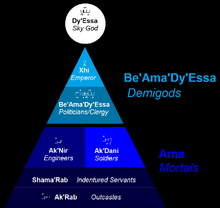
Allosoph Social Pyramid
Xhi: Emperor, a hereditary monarch appointed by his predecessor, the living incarnation of the Sky god Dy'Essa
Be'Ama'Dy'Essa: those in relation to the royal family, believed to be the descendants of Dy'Essa. Incest is a sin, so the royalty must marry those from the mortal class, usually someone from the Ak'Dani caste. Males hold political office, while females are priestesses. Only males are authorized to have children, females must remain virgins. Their patron god is Dy'Essa, the ruler of the gods and lord of the skies.
- Lad: Eligible to become Xhi
- Zpa: Can take office in federal government
- Bukin: Can take office in local government
- Eshu: Ambassadors & Judges
Ak'Dani: Mortal warriors, enlisted in the emperor's military. The best veterans are married off to members of the Be'Ama'Dy'Essa royal family. Their patron god is Dy'Chavab, god of defense and protection.
- Lad: Army officers
- Zpa: Intelligence
- Bukin: Armored & Mechanized infantry & special divisions
- Eshu: Law Enforcement, Public Security, Emergency Fire/Medical services
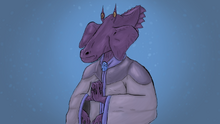
Artwork courtesy of Minegamer114
Ak'Neer: Engineers, those who create machines and structures which defy the forces of gravity. To the allosoph skyscrapers are analogous to cathedrals: holy, sacred temples. Tall monuments are erected to honor Dy'Essa and the royal family. Their patron god is Dy'Oingk, god of creation and diligence.
- Lad: Doctors, Scientists, Pharmaceuticals, Attorneys
- Zpa: Architects, Engineers, Chemists. White-collar jobs
- Bukin: Plumbing, Auto-Repair, Construction. Blue-collar jobs
- Eshu: Farming, Agriculture
Ak'Rab: Those who refuse to enlist in the military or formal education are viewed with contempt. The Ak'Rab are viewed as heretics, and to prevent them from speaking dissent against the royalty their mantles are amputated from their scalps, rendering them mute. This makes them both visibly marked for their treason and prevents them from spreading dissent and opposition. Rab is also a profanity, used to slander those one dislikes.
- Shama'Rab: Ak'Rabs seeking forgiveness from the Xhi Dynasty. They are indentured servants to the Be'Ama'Dy'Essa, coerced to perform tedious and often dangerous jobs in society. Female Shama'Rab often become courtesans for the Xhi aristocracy, while males are usually enlisted into the military, often the first o be sent to battle to spare the Ak'Dani from unnecessary fatalities. A Shama'Rab can be promoted to the higher castes of society once they are absolved of their sins by the nobility.
Religions:[]
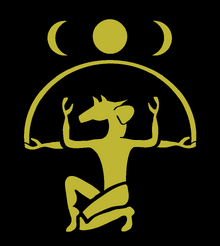
A depiction of Dy'Essa: the King of the Gods in Anudanima Mythology
Anudanima:[]
Anudanima or "The Devout Followers," is the largest religion of Dengea, with 4.5 billion adherents. It is a henotheistic faith that worships the Sky god Dy'Essa, the patron god of the allosoph. The Allosophi royal family claim to be the descendants of Dy'Essa.
The religion traces its origins back to early Anuga shamanism in the Pat'Toran Mountains. The earliest forms of caste system and pantheons were made at this time. The society was led by E'Gas (feminine O'gas) who served as both political and religious leaders. Anuga culture and religion valued strength, and not mercy. They lived so high above sea level, 5125 meters, that their breathing and oxygen intake was different from other Allosoph. This, along with the frigid temperatures, made Anuga culture isolated from the outside world until the arrival of the Toric Empire in 390 AD.
The Toric Empire, led by the Imperator, managed to conquer all the Anuga Tribes. Some E'Ga chieftains initially fought against his rule but ultimately surrendered by the 5th century CE.
Anuga shamans suspected the Imperator to be the prophesied Kaza: the evil demon from below the mountains to one day conquer the Anuga politically and then conquer the planet. The prophecy foretold of a E'Ga born with the strength of the sky god Dy'Essa to overcome the Kaza. He was known as the Xhi.
The Xhi rallied up an uprising and descended from the mountains to take the royal palace for himself. The Toric empire was swiftly defeated in a 20-year conflict and the Xhi was pronounced ruler of all the Imperator's holdings. His first proclamation was to give his military officers political power over the territories. From that point forward those from the military caste, the Ak'Dani, were responsible for local government and the Xhi's descendents, known as the Children of Dy'Essa, were in charge of federal government.
To be continued....
Other Faiths:[]
Ama'Sati or "Honest People" believe the royal family to be illegitimate because Mahila, the mother to the Xhi Dynasty, was not married to Dy'Essa and had an adulterous relationship. They believe the imperial family have made a mockery of the goddess Dy'Nei, wife of Dy'Essa, and that the royals are heretics, or Ak'Rabs.
Rab'Xhi or "Rebel Emperors," is a cult founded by Ak'Rabs who believe the emperor has no true authority and that everyone is equal under Dy'Essa. They question the validity of the church and believe the royal family lied of their inheritance, insisting the last heir in the Dy'Essa bloodline died millennia ago.
Zr'Ko or "Life-Death," was a dualistic faith with two gods: Zr, the goddess of Life and Peace, and Ko, the God of Death & War. The religion prioritizes the pleasures and euphoria life has to offer, including sexuality, narcotics and other luxuries. The religion was viewed with severe disdain by the Xhi Anuga, who purged its followers for centuries. This religion was quite prominent is Southern Dycegea during the Age of Divergence
Mharianity, better known as the Church of Eight, was a polytheistic religion founded on the Antoligea continent circa 16th century BC. The religion was known for its ritualistic scarifies of pushing people from tall platforms known as the Sacred Escalators. The religion was governed by Eight Shamans, each a mortal incarnation of one of the eight deities from Mharian mythology.
Chausuism was a religion worshiped in northwest Dycegea, founded circa 250 AD. The religion was non-theistic and worshiped Dy'Dani'La, the personification of wisdom and knowledge. This personification of knowledge was later incorporated into Anudanima mythology as a lesser deity.
